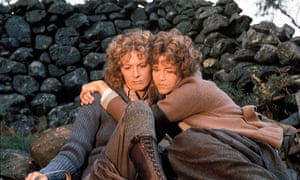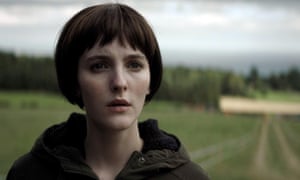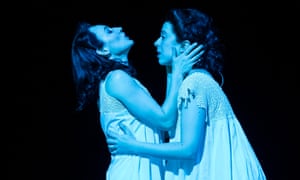Joan Rivers and Barbra Streisand: the myth of their lesbian play
Before they were superstars, Joan Rivers kissed and tried to kill a young Barbra Streisand on stage – or so she claimed. Now her tall tale has inspired drama The Funny Girls

In the late 1950s, a 25-year-old struggling actor named Joan Molinsky – later to become better known as the acerbic comedian Joan Rivers – landed a small part as a lesbian stalker in an off-off-Broadway play called Seaweed. “The primary qualification for being cast,” her biographer Leslie Bennetts later wrote, seemed to be “that she had lots of relatives who would come see her in a play”. The significance of Seaweed from a historical point of view is that she was starring opposite another superstar-in-waiting, whom she described in her memoir Enter Talking as “a skinny high school girl with a large nose and a pin that said, ‘Go Erasmus!’”.
This was 17-year-old Barbra Streisand, who played her unlucky victim. Rivers recalled “a big love scene in which I told Barbra I loved her very much and she rejected me and I had a knife in my hand and tried to kill her and then myself”. It’s delicious to imagine these two future divas in a clinch in some airless New York attic in front of an audience “sitting there in overcoats … coughing, like a tubercular ward”, as Rivers put it.
Unfortunately, her story was almost complete bunkum. The play was Driftwood, not Seaweed. It contained no mention of lesbianism, as its author Maurice Tei Dunn explained in 1995. “I can’t imagine where Joan got that,” he said. “In those days, it would have been suicide in the theatre.” The women didn’t even share any scenes; the photograph of them together which Rivers included in her book was snapped during rehearsals.
Yet the allure of the story persists. Last year, Sue Perkins dramatised it in When Joan Kissed Barbra, a short film in Sky’s Urban Myths series starring the comedian Katherine Ryan as Rivers. Now, the playwright Roy Smiles imagines what happened before the show in his drama The Funny Girls. Writers have done a roaring trade speculating about celebrity encounters real or imagined, from Peter Morgan (The Audience, The Crown, Frost/Nixon) to Terry Johnson (Insignificance, Hitchcock Blonde); Smiles has made it his speciality, bringing together Groucho Marx and Lenny Bruce in his play Schmucks, and dramatising the break-up of Marilyn Monroe and Arthur Miller in Reno. After finishing his play Kurt and Sid – Cobain and Vicious, that is – he turned to The Funny Girls as an uplifting palate-cleanser.
The first act takes place backstage, as Streisand frets about her mother being in the audience for such a scandalous play, and pleads with Rivers to replace the word “lesbian” in the text with “thespian”. Act Two transports us to a different dressing room a decade later: now Streisand is a fully fledged star, married to Elliott Gould, and surprised to find Rivers waiting for her when she comes off stage after a Las Vegas concert. The woman who later confessed in her memoir that she didn’t want to end up as “ordinary Joan Molinsky” bristles, in Smiles’ imagining at least, at the superstar Streisand has become.
What does he think they envied about one another? “Streisand is obviously one of the greatest singers of all time,” Smiles says. “But she was also stepping on to Rivers’ territory with her comic ability. She started out as a serious singer and then proved in Funny Girl that she had comic range as well. By the time she made The Owl and the Pussycat and What’s Up, Doc? she is already this amazing comic performer. Rivers must have envied that versatility.”
As the cult of Streisand grew – “It’s almost a quasi-religion,” he says – perhaps there was some reciprocal envy. No one as adored and elevated as Streisand became in the 1970s could risk the spikiness so natural to Rivers; after all, it’s hard to be iconoclastic when you’re an icon. “Streisand may well have envied her attitude,” Smiles agrees. “Rivers mocked everyone, took no prisoners, got into feuds. Streisand couldn’t have behaved like that even if she had wanted to.”
The Funny Girls, though, is interested in their similarities rather than their differences. “Both women had this determination,” he explains. “They’d heard the same thing from their mothers: you’re terrible-looking, get a job, get a husband. But they were determined to make their dreams come true. Streisand may be an egomaniac but she also needed so much self-belief during the period when the first part of The Funny Girls is set because she was sleeping on friends’ couches. Rivers was supposed to be this Jewish princess and here she was, divorced before she was 30 and going out into this very male comedy world. They both overcame the dream slayers.”
I was hoping for a theory about why Rivers kept the Seaweed/Driftwood lie afloat for so long. She was still trotting it out in 2010; when Rivers died four years later at the age of 81, Streisand called her “a real character then and now”. But Smiles thinks the comic’s motive wasn’t complicated. “She did it for the same reason she did most things,” he says. “Because it was funny.”
The Funny Girls is at the New Wimbledon theatre, London, from 17-24 September.



